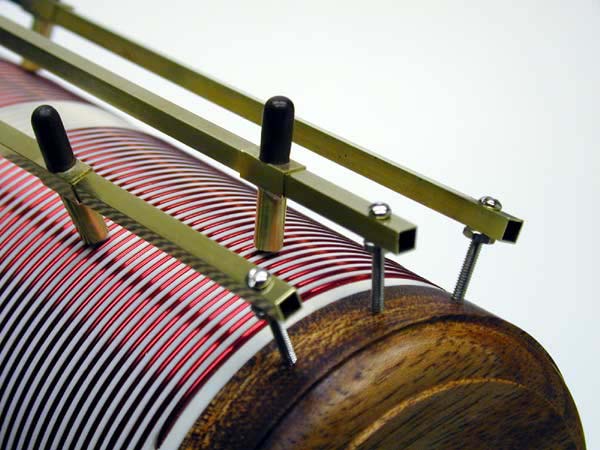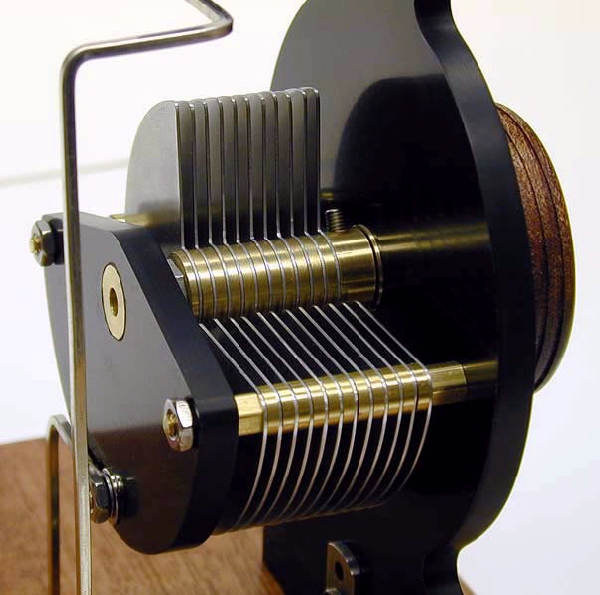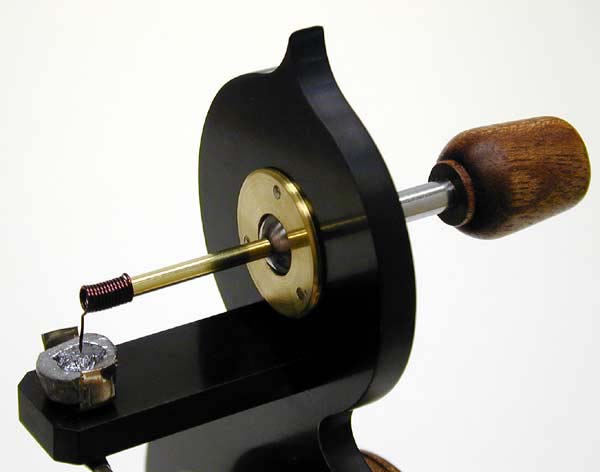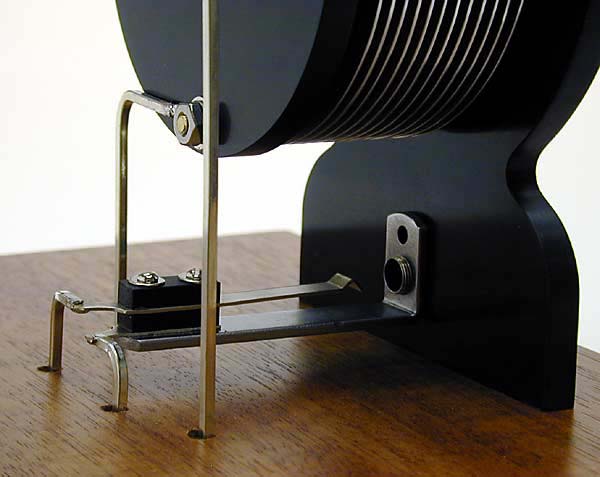

by Rick Weber
To see Rick's web site on the set click here!
This shortwave crystal radio receiver was designed specifically for the Internet-Based Crystal Radio Set Club Contest with simplicity and elegance foremost in mind. The design is completely freelance and evolved as the project progressed. The general style is 1920’s vintage radio with generous use of Mahogany, Ebony, black phenolic and polished brass. No drawings were made. The design allows for a variety of tuning configurations to facilitate experimenting.

I machined every component of the radio from scratch. The only exception to the hand crafted parts are nuts, bolts, and washers.

My building entry is for the Master Class Division of the Homebrew Catagory of the Contest.
Construction Details:
Coils:
The coil form is made from 3-inch PVC pipe, turned down in a lathe to a thin wall. A 10 turns-per-inch groove was then cut into this cylinder with the lathe’s thread cutting capability so that the bottom of the groove is paper thin. This, of course improves the Q of the coil. The coil is wound from 16 AWG solid enameled copper, which is .050 inch diameter. The spiral groove
spaces the coils .100 inch apart, leaving exactly .050 inch in between coils - an ideal spacing for solid wire solenoid coils.

Making the coil in this manner removes the problem of picking up too much inter coil capacitance of closely spaced enameled wire coils and also allows for the great advantage of incorporating sliders that are capable of picking up each and every coil. There are no messy taps to deal with.
There are three slider taps for the coils - one for the primary and two for the secondary. The three slider taps for the coil include spring-loaded ball-tipped plungers to engage the coil. (The photos were taken before the enamel was removed under the path of each sliding tap.) A walnut handle is attached to each slider.
The coil form can be easily disassembled and rewound with a wide variety of turns of wire. It currently has a primary of 13 turns and a secondary of 31 turns. This covers the shortwave stations that I am particularly interested in. The schematic shows two of several variations for the slider taps.
The Mahogany end caps of the coil form are removable to allow access to the coil wire. The two supporting posts for the coil are drilled with a long #30 aircraft drill to provide a pathway for the wires to go to the base of the radio.
Air Variable Capacitor
This component is 100% scratch built. (I would not advise encourage anyone to build an air variable. They are a lot harder and more time consuming to construct than they look!)

The phenolic front panel of the radio also serves as the front plate of the capacitor, thereby keeping the design simple and elegant looking. The capacitor plates - 11 rotor and 12 stator - are individually hand cut from aluminum sheet. The spacers for rotor and stator plates are turned from brass. The shaft is steel. The capacitance ranges from 30 to 390 picofarads.
Knobs and Base
The center portion of the main tuning knob and the handle of the tickler arm are made of Mahogany.
The dial portion of the tuning knob is turned from 1/4 inch thick black phenolic and polished. A .032 inch diameter (!) end mill was used to cut the divisions on the dial which was indexed on a dividing head clamped to the mill table.

The Base is made of Mahogany. A milled slot accepts the removable front panel with no other fasteners needed. The black pillars are also press fit and easily removable. Wiring connections come together in the hollowed-out bottom of the base.
Phone Jack and Terminal Posts.
This part was made from steel and black phenolic. It accepts a
standard 1/4 inch phone jack.

Tickler Assembly
To keep the design clean and classy, a ball joint was incorporated into the front panel.

A steel shaft with a steel spherical ball was turned. A smaller brass shaft is fitted to the ball coaxially with the steel shaft. A variety of tickler wires can be fitted to the brass shaft.
Two brass plates sandwich the ball in the front panel. A crystal holder keeps a germanium crystal pot.
Wiring
All exposed wire is made of vintage style tinned square bus wire.